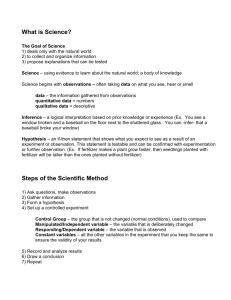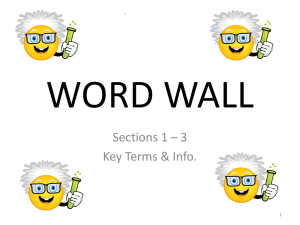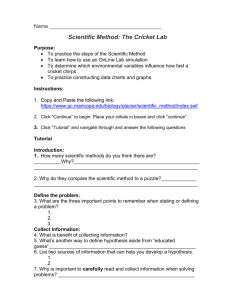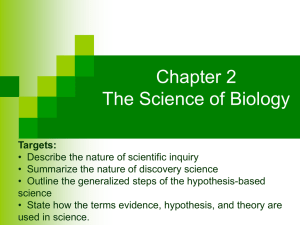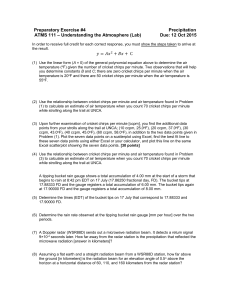The Scientific Method
advertisement
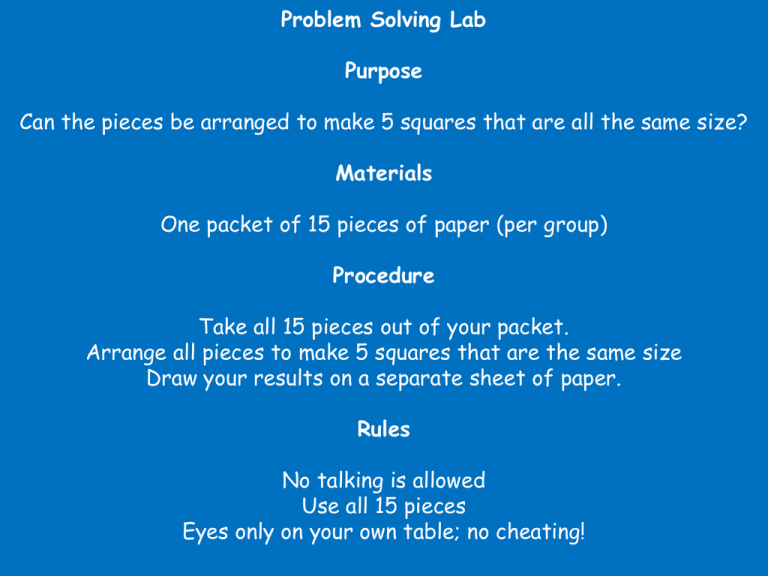
Problem Solving Lab Purpose Can the pieces be arranged to make 5 squares that are all the same size? Materials One packet of 15 pieces of paper (per group) Procedure Take all 15 pieces out of your packet. Arrange all pieces to make 5 squares that are the same size Draw your results on a separate sheet of paper. Rules No talking is allowed Use all 15 pieces Eyes only on your own table; no cheating! Created by Liz Bartimus The Scientific Method is a series of steps that are used to investigate a natural occurrence. Step 1-Problem/Question: The scientific method starts when you ask a question about something that you observe: How, What, When, Who, Which, Why, or Where? And, in order for the scientific method to answer the question it must be about something that you can measure, preferably with a number. Step 2-Observation/Research: Make observations and research your topic of interest. THINK ABOUT THE NEXT FEW QUESTIONS YOU WILL SEE. ARE THEY SOMETHING THAT CAN BE MEASURED AND TESTED SCIENTIFICALLY? 1. Are there more seeds in Fugi Apples or Washington Apples? 2. What types of apples grow in Missouri? 3. Why do people smoke? 4. How does talking to a plant affect a plants height? 5. Where are whales found in the world? 6. What happens if you do not eat breakfast? 7. Which planet is the most interesting one to study? 8. Which objects are attracted by a magnet: paperclip, penny, foil? 9. Will larger or smaller seeds germinate faster? 10. Do larger or smaller seeds make prettier flowers? 11. Do flying saucers really exist? 12. Which pill design – tablet, caplet, or capsule – will dissolve faster? 13. Does the color of a surface affect its temperature? 14. Why does doing homework help your grades? 15. How does the size of a helicopter’s blade length affect the speed and number of rotations? 16. Does the temperature of a classroom affect student performance? 17. How does talking to a plant affect the plant? JOURNAL SM1 Write: 1. An observation about the cricket 2. A problem question about this observation that you can study. Step 3-Develop a Hypothesis: Predict a possible answer(an educated guess) to the problem or question. It must be testablesomething that can be proved right or wrong AND easily measured. Use if and then statements. Example: If soil temperatures rise, then plant growth will increase because warmer soil makes plants grow more. JOURNAL SM2 Write a hypothesis based on this question: “ Will empty trucks use the same amount of gas as heavily loaded trucks? Step 4-Experiment: a test to used to see if your hypothesis is right. They follow a procedure ( a set of detailed steps) and include a detailed materials (what you will use) list. The outcome must be measurable (quantifiable with numbers). >With experiments comes a LOT of vocabulary: • Variable-something that is can change in an experiment. To keep things straight, remember DRYMIX • Dependent Variable-what you measure; it changes because of the independent variable; it is also called the… • Responding variable because it responds to a change in something else. It is graphed on the ……. • Y axis on a graph • Manipulated variable is the one and only thing you change and test ON PURPOSE. Also called…. • Independent • X axis Variable which is graphed on the… JOURNAL SM 3 We conducted two labs related to writing a hypothesis. Develop three variables for each lab: Möbius Strip 1 2 3 Coin Conundrum 1 2 3 • Control Group-An experimental group that has no changing variable during the experiment. Used for comparison. • Constants-the variables that are the same for everything . For example if we wanted to see if more class time to start HW made a difference in grades we would keep the amount and type of HW the same for everyone. Only the time in class to do the HW would be diferent. • Trial-a task that should be repeated several times to be sure your results are consistent or similar JOURNAL SM 4 Using the information you wrote down for SM 3, identify the following for each lab. Möbius Strip Independent Variable: Dependent Variable: Constants: Coin Conundrum Independent Variable: Dependent Variable: Constants: JOURNAL SM 5 Write these questions down then analyze the data on the next slide. 1. Identify the independent and dependent variable. 2. As the temperature increases, what happens to the number of chirps per minute? 3. How many chirps per minute would you expect when the temperature is 10 0C? JOURNAL SM 5 Analyze the data: Cricket 15 0C 20 0C 25 0C 1 91 135 180 2 80 124 169 Average Chirps vs. Temperature 180 160 140 3 89 130 176 4 78 125 158 120 100 80 5 77 121 157 Average Chirps 83 127 168 60 40 20 0 0 5 10 15 20 25 Step 5-Collect and Analyze Results: Modify the procedure if needed. Confirm the results by retesting. Include tables, graphs, diagrams and photographs. Step 6-Conclusion: A decision based on results. The conclusion is important because it explains the results of the lab and what you learned by doing it. 1. State the facts. Exact numbers, details, variables, etc. . 2. Say WHY!....Explain why something did or did not happen. 3. Wrap It Up! Talk about what you could do differently, sources of error, future tests. NOT INCLUDING A CONCLUSION PARAGRAPH WILL AUTOMATICALLY DROP A LAB GRADE! Step 7-Communicate the results by writing a report or telling somebody. Be sure that you do not include your personal bias or opinion. Just state the facts. It is important that you know the steps of the scientific method in order. JOURNAL SM 6 Analyze the data: 1. Does the data support the hypothesis that chirp more in warmer temperatures? Explain 2.What would you do next if this were your data? 3.Can you draw a conclusion from this data? Why or why not? Cricket 15 0C 20 0C 25 0C 1 98 100 120 2 92 95 105 3 101 93 99 4 102 85 97 5 91 89 98 Average Chirps 96 92 103 AFTER EXPERIMENTING When an experiment can be repeated proving a hypothesis true over and over, the hypothesis can become a theory. A theory is a welltested explanation for a lot of observations or experimental results. A scientific law can be the final result of testing. Usually that describes patterns that are observed in nature that are true ALL the time-like the Law of Gravity. SCIENTIFIC METHOD STEPS-Do you know them? Identify the Problem Research/ Gather Info Form a Hypothesis If…… then….. statement Test the Hypothesis Retest! Hypothesis is right Analyze and Conclude Communicate Results If your hypothesis is wrong JOURNAL SM 7 1. If your hypothesis was incorrect. What should you do? 2. Is only one trial of an experiment enough to base a conclusion on ? Why or why not? 3. Why is a conclusion important? 4. Contrast a theory and a law.

